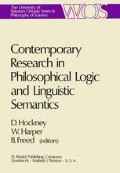Abstract
The following dialogue is drawn from Plato’s Cratylus.
This paper derives from an earlier version entitled ‘Buridan and Two-Dimensional Model Theory’ delivered at Waterloo University in the Summer of 1969. Another version was given at Livingston College, Rutgers University in December 1971. My understanding of Buridan has been greatly helped by many discussions with Calvin Normore and Paul Spade. Recently John Martin has worked out some further developments in two-dimensional semantics, and I have benefitted from discussing this work with him.
Access this chapter
Tax calculation will be finalised at checkout
Purchases are for personal use only
Preview
Unable to display preview. Download preview PDF.
Notes
In N. Hanson’s sense of ‘conceptual possibility’ described in his Patterns of Discovery (P. 84).
John Buridan: Sophisms on Meaning and Truth, T. K. Scott, ed. (p. 83)
Nyaya Philosophy, trans. by D. Chattopadhyaya and M. Gangopadhyaya, Indian Studies Publication, Calcutta, 1967.
Aristotle, Metaphysics, Book Gamma, 1011b27.
G. W. Leibniz, General Inquiries About the Analysis of Concepts and of Truths, §1 (1686). Reprinted in G. H. R. Parkinson, Leibniz: Logical Papers.
A. Tarski, ‘The Semantic Conception of Truth’, §18.
Buridan, Sophisms (p. 181).
Buridan, Sophisms (p. 183).
On the first claim, see J. Ashworth, The Theory of Consequence in the Late Fifteenth and Early Sixteenth Centuries Notre Dame Journal of Formal Logic 14 (1973), 289–315.
On the second claim see for example, B. Mates, ‘Leibniz on Possible Worlds’ in Logic, Methodology and Philosophy of Science III, 1968, B. van Rootselaar and F. Staal, eds.
Buridan, Sophisms (p. 92).
And possibly inconsistencies as well. See P. Spade, The Mediaeval Liar, Ph. D. dissertation, Toronto 1972.
Buridan, Sophisms (p. 92).
L. Wittgenstein, Tractatus Logico-Philosophicus §4. 463.
Buridan, Sophisms (p. 182). This doctrine was noted in E. Moody, Truth and Consequence in Mediaeval Logic, 1953, and has been discussed by others, notably A. Prior in ‘The Possibly-True and the Possible’, Mind 1970.
Buridan, Sophisms (p. 183).
S. Jaskowski, ‘Investigations into the System of Intuitionist Logic’ 1936, reprinted in S. McCall, Polish Logic. A brief survey of product-logics can be found in Ch. 2 §16 of N. Rescher’s Many-Valued Logic. Łukasiewicz advocated a particular four-valued product logic in his ‘A System of Modal Logic’, 1953, reprinted in Jan Łukasiewicz: Selected Works, L. Borkowski, ed.
Other product logics in four values are given in A. Church, ‘Non-Normal Truth-Tables for the Propositional Calculus’, Boletin de la Sociedad Matematica Mexicana, 1953, and in A. Church, Introduction to Mathematical Logic v. 1, exercise §19.9.
See Bas van Fraassen, ‘Presupposition, Implication, and Self-Reference’ Journal of Philosophy, 1968, and references cited therein.
It is not uncommon to find the Fregean principle taken as an initial working hypothesis from which departures and exceptions are assessed. Cf. Laurence Horn, On the Semantic Properties of Logical Operators in English, Ph. D. dissertation, UCLA 1973; and also the work of Lauri Karttunen.
Some historical remarks on this idea can be found in my paper, ‘Truth and Modality in Semantically Closed Languages’, in The Paradox of The Liar, Robert L. Martin, ed.
See Bas van Fraassen, Formal Semantics and Logic, Ch. III §6, Ch. V §3.
Editor information
Rights and permissions
Copyright information
© 1975 D. Reidel Publishing Company, Dordrecht-Holland
About this chapter
Cite this chapter
Herzberger, H.G. (1975). Dimensions of Truth. In: Hockney, D., Harper, W., Freed, B. (eds) Contemporary Research in Philosophical Logic and Linguistic Semantics. The University of Western Ontario Series in Philosophy of Science, vol 4. Springer, Dordrecht. https://doi.org/10.1007/978-94-010-1756-5_4
Download citation
DOI: https://doi.org/10.1007/978-94-010-1756-5_4
Publisher Name: Springer, Dordrecht
Print ISBN: 978-90-277-0512-9
Online ISBN: 978-94-010-1756-5
eBook Packages: Springer Book Archive

